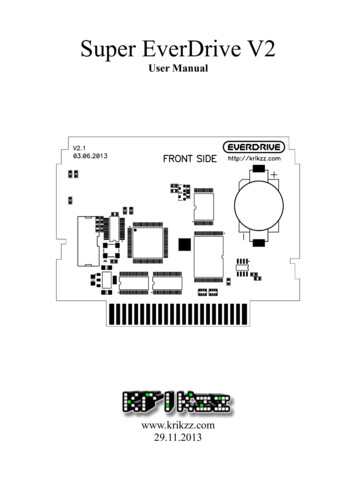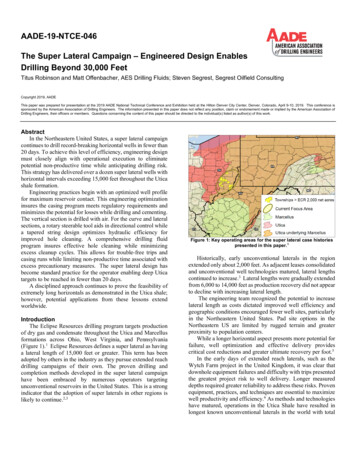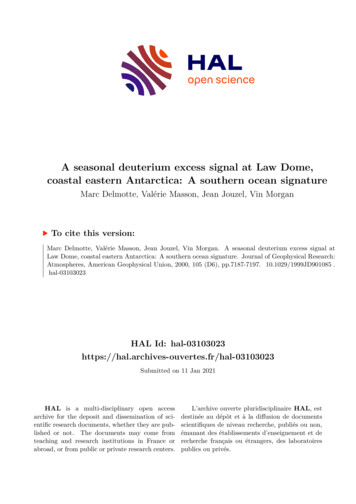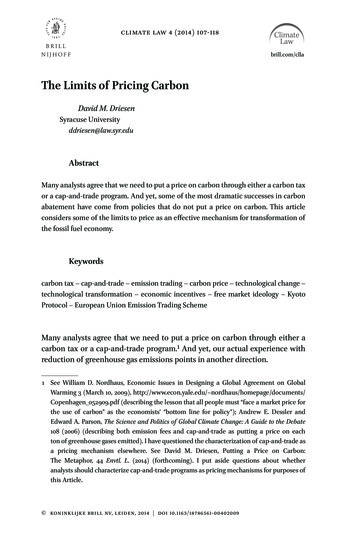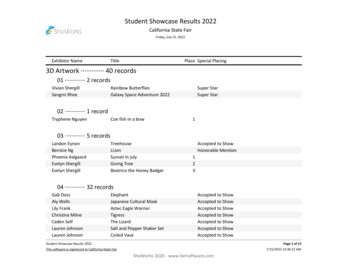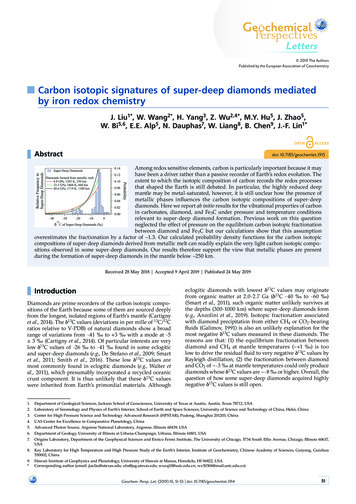
Transcription
2019 The AuthorsPublished by the European Association of GeochemistryCarbon isotopic signatures of super-deep diamonds mediatedby iron redox chemistryJ. Liu1*, W. Wang2*, H. Yang3, Z. Wu2,4*, M.Y. Hu5, J. Zhao5,W. Bi5,6, E.E. Alp5, N. Dauphas7, W. Liang8, B. Chen9, J.-F. Lin1*Abstractdoi: 10.7185/geochemlet.1915Among redox sensitive elements, carbon is particularly important because it mayhave been a driver rather than a passive recorder of Earth’s redox evolution. Theextent to which the isotopic composition of carbon records the redox processesthat shaped the Earth is still debated. In particular, the highly reduced deepmantle may be metal-saturated, however, it is still unclear how the presence ofmetallic phases influences the carbon isotopic compositions of super-deepdiamonds. Here we report ab initio results for the vibrational properties of carbonin carbonates, diamond, and Fe3C under pressure and temperature conditionsrelevant to super-deep diamond formation. Previous work on this questionneglected the effect of pressure on the equilibrium carbon isotopic fractionationbetween diamond and Fe3C but our calculations show that this assumptionoverestimates the fractionation by a factor of 1.3. Our calculated probability density functions for the carbon isotopiccompositions of super-deep diamonds derived from metallic melt can readily explain the very light carbon isotopic compositions observed in some super-deep diamonds. Our results therefore support the view that metallic phases are presentduring the formation of super-deep diamonds in the mantle below 250 km.Received 28 May 2018 Accepted 9 April 2019 Published 24 May 2019IntroductionDiamonds are prime recorders of the carbon isotopic compositions of the Earth because some of them are sourced deeplyfrom the longest, isolated regions of Earth’s mantle (Cartignyet al., 2014). The δ13C values (deviations in per mille of 13C/12Cratios relative to V-PDB) of natural diamonds show a broadrange of variations from -41 ‰ to 3 ‰ with a mode at -5 3 ‰ (Cartigny et al., 2014). Of particular interests are verylow δ13C values of -26 ‰ to -41 ‰ found in some eclogiticand super-deep diamonds (e.g., De Stefano et al., 2009; Smartet al., 2011; Smith et al., 2016). These low δ13C values aremost commonly found in eclogitic diamonds (e.g., Walter etal., 2011), which presumably incorporated a recycled oceaniccrust component. It is thus unlikely that these δ13C valueswere inherited from Earth’s primordial materials. Althougheclogitic diamonds with lowest δ13C values may originatefrom organic matter at 2.0-2.7 Ga (δ13C -40 ‰ to -60 ‰)(Smart et al., 2011), such organic matter unlikely survives atthe depths (300-1000 km) where super-deep diamonds form(e.g., Anzolini et al., 2019). Isotopic fractionation associatedwith diamond precipitation from either CH4 or CO2-bearingfluids (Galimov, 1991) is also an unlikely explanation for themost negative δ13C values measured in these diamonds. Thereasons are that: (1) the equilibrium fractionation betweendiamond and CH4 at mantle temperatures ( 1 ‰) is toolow to drive the residual fluid to very negative 13C values byRayleigh distillation; (2) the fractionation between diamondand CO2 of -3 ‰ at mantle temperatures could only producediamonds whose δ13C values are -8 ‰ or higher. Overall, thequestion of how some super-deep diamonds acquired highlynegative δ13C values is still open.d1.Department of Geological Sciences, Jackson School of Geosciences, University of Texas at Austin, Austin, Texas 78712, USA2.Laboratory of Seismology and Physics of Earth’s Interior, School of Earth and Space Sciences, University of Science and Technology of China, Hefei, China3.Center for High Pressure Science and Technology Advanced Research (HPSTAR), Pudong, Shanghai 201203, China4.CAS Center for Excellence in Comparative Planetology, China5.Advanced Photon Source, Argonne National Laboratory, Argonne, Illinois 60439, USA6.Department of Geology, University of Illinois at Urbana-Champaign, Urbana, Illinois 61801, USA7.Origins Laboratory, Department of the Geophysical Sciences and Enrico Fermi Institute, The University of Chicago, 5734 South Ellis Avenue, Chicago, Illinois 60637,USA8.Key Laboratory for High Temperature and High Pressure Study of the Earth’s Interior, Institute of Geochemistry, Chinese Academy of Sciences, Guiyang, Guizhou550002, China9.*Hawaii Institute of Geophysics and Planetology, University of Hawaii at Manoa, Honolulu, HI 96822, USACorresponding author (email: jiacliu@utexas.edu; afu@jsg.utexas.edu; wuzq10@ustc.edu.cn; wz30304@mail.ustc.edu.cn)Geochem. Persp. Let. (2019) 10, 51-55 doi: 10.7185/geochemlet.191451
Geochemical Perspectives LettersLetterThrough plate tectonics, relatively oxidised iron andcarbon species at the Earth’s surface are transported to thedeep mantle by subducted slabs, where Fe2 can disproportionate into Fe3 and metallic Fe (Equation 1) below 250 kmdue to stabilisation of Fe3 in garnet, pyroxene and bridgmanite (Frost et al., 2004; Rohrbach et al., 2007):3FeO Fe Fe2O3Eq. 1The resulting metallic Fe would react with carbonates to formeither diamond (Equation 2) or iron carbide (Equation 3),depending on the local Fe:C ratio and thus redox state (Palyanov et al., 2013):FeCO3 2Fe 3FeO CEq. 2FeCO3 5Fe 3FeO Fe3CEq. 3Fe3C can also serve as a reduced C source to form diamondsthrough the following redox reaction (Bataleva et al., 2016):Fe3C 3Fe2O3 9FeO CEq. 4Moreover, Fe-C alloys/mixtures may melt under the pressureand temperature (P-T) conditions of the mantle because oftheir relatively low melting temperatures, especially in thepresence of Ni, as compared to other mantle minerals (e.g.,Rohrbach et al., 2014; Liu et al., 2016). The resultant Fe-C meltcan form diamonds through the reaction mediated by ironredox chemistry:Fe-C melt Fe2O3 3FeO CEq. 5The presence of S or other light elements can significantly lowerC solubility in metallic melt and therefore promote diamondformation (Bataleva et al., 2015). For example, Fe-Ni-S-C inclusions have been found in super-deep diamonds (e.g., Kaminskyand Wirth, 2011; Smith et al., 2016). Finding such metallicinclusions requires careful examination as these inclusions aresmall in size (µm to nm scale) and can be mistaken for graphite(Kaminsky and Wirth, 2011; Smith et al., 2016). The presence ofmetallic inclusions supports the view that C-bearing metallicmelt could serve as a carbon source for some super-deepdiamonds below 250 km.PDOS of Fe and C in Minerals Relevantto Diamond FormationThe DFT U calculation was verified by comparing the theoretical PDOS of Fe2 in FeCO3 with the one measured by NRIXS(Fig .1). The PDOS results in theory and experiment matchwell with each other, which could also support the validityof the calculated β-factors of C in carbonates, diamond andnonmagnetic Fe3C (Fig. S-1). Synchrotron Mössbauer spectra(Fig. S-2) and optical images (Fig. S-3) show that the spintransition of Fe2 in FeCO3 occurs between 44-46 GPa at 300K. Across the spin transition, the unit cell volume collapsesby 9.4 %, the Fe-O bond length is shortened by 4.8 % (Fig.S-4). Meanwhile, the spin transition of iron results in 5 %decrease of the β-factor of C in LS FeCO3 compared to its HSstate (Fig. S-5) as the C-O bound length is lengthened by 2.1% (Fig. S-4). The magnetic state of Fe3C changes from ferromagnetic at ambient condition to paramagnetic and finallynonmagnetic at pressures higher than 22-60 GPa (Lin et al.,2004; Gao et al., 2008). Therefore, nonmagnetic Fe3C is therelevant phase for most mantle depths. Similar to previoustheoretical calculations (Horita and Polyakov, 2015) and Cisotopic measurements on natural diamonds and iron carbideinclusions (Mikhail et al., 2014), the magnitude of ΔC Dia-Fe3Cis larger than other inter-mineral fractionations involvingdiamond, such as ΔC Dia-Carbonates (Fig. S-6). Our calculatedΔC Dia-Fe3C values along the representative P-T conditions ofmodern mantle and cold slab (Fig. S-6) are as much as 27 %lower than the 1-bar value of ΔC Dia-Fe3C reported by Horita andPolyakov (2015). Therefore the 1-bar data would overestimatethe C isotopic fractionation during diamond formation from aFe3C source under mantle P-T conditions.Carbon Isotopic Fractionation inDiamonds through Redox ReactionsEq. 6As discussed by Horita and Polyakov (2015), the most significant reaction that can impart C isotopic fractionation todiamonds is one involving the oxidation of C alloyed withmetallic melt to release C to form diamonds (Equation 5). Toassess how redox reactions involving Fe-C melt below 250 kmcan influence the δ13C values of super-deep diamonds, wemodelled the isotopic fractionation of C between diamond andFe-C melt. Our calculations accounting for various P-T andcompositional factors allow us to test whether this diamondformation pathway can account for their δ13C values.where A and B are two phases in isotopic equilibrium. Animportant assumption that Horita and Polyakov (2015) madeis that pressure has no effect on this fractionation. However,super-deep diamonds form under high P-T conditions inthe mantle below 250 km depth, and applied pressure hasundoubtedly been shown to stiffen lattice bonds and inducestructural and electronic transitions, which in turn can affectβ-factors of C in host phases (e.g., Lin et al., 2004, 2012). Inorder to constrain reliably the extent of C isotopic fractionation during super-deep diamond formation, we used DFTaugmented by a Hubbard U correction method (Giannozziet al., 2009) to calculate the β-factors of C in MgCO3, FeCO3,Fe3C and diamond (Tables S-1, S-2) at the P-T conditions ofsubducted slabs in the mantle. We also measured the PDOSof Fe2 in FeCO3 by nuclear resonant inelastic X-ray scattering(NRIXS) spectroscopy (Dauphas et al., 2018) to evaluate theaccuracy of the theoretical calculations.The C isotopic fractionation can be modelled by usinga Rayleigh distillation if the diamonds produced do not backreact with the C source, which is reasonable if the Fe-C sourceis a melt and the reaction product is a solid characterised by alow self-diffusivity (Koga et al., 2005). As it is challenging tocalculate the β-factor of C in Fe-C melt directly, Δ13C Dia-FeC meltis calculated by the sum of Δ13C Dia-Fe3C (Fig. S-6) and the equilibrium fractionation Δ13C Fe3C-FeC melt -5.6 106/T2 anchoredto the experimentally determined value of -2 ‰ at 6.3 GPaand 1673 K (Reutsky et al., 2015). By using this calculatedΔ13C Dia-FeC melt, δ13C values of diamonds forming from metallicmelt can be calculated using a Rayleigh distillation model.Relative to the Fe-C melt source, the diamonds are enrichedin the heavy isotope of C. Removal of isotopically heavydiamonds would have driven the Fe-C melt reservoir towardslower δ13C values and diamonds formed from this low δ13Creservoir progressively acquired more negative δ13C values.Horita and Polyakov (2015) have attempted to addressthe aforementioned question through calculations of thereduced partition function ratio (β-factor) of C in Fe3C usingthe heat capacity and the iron phonon density of states (PDOS)at 1 bar. They combined this β-factor with previously publishedβ-factors of diamond and carbonates to calculate the carbonequilibrium isotopic fractionation Δ13C between these phases,Δ13C B-A 1000(lnβB - lnβA)Geochem. Persp. Let. (2019) 10, 51-55 doi: 10.7185/geochemlet.191452
Geochemical Perspectives LettersLetterFigure 1 Partial phonon density of states (PDOS) of 57Fe (a, b) and 12C (c, d) in FeCO3 at high pressures. In (a) and (b), the open cyclesare PDOS of Fe measured by NRIXS; the blue curves are calculated PDOS of Fe by DFT U. The red curves in (c) and (d) are calculatedPDOS of C. The lowest energy peak at 20-40 meV can be attributed to the acoustic phonons. According to previous high pressureRaman and infrared studies of FeCO3 (Santillán and Williams, 2004; Lin et al., 2012), the other peaks can be assigned to librationalmode (L), translational mode (T) and in-plane bending mode (v4), out of plane bending vibration (v2) and asymmetric stretch (v3)of CO32- (marked as dashed vertical lines). The energies of v2 and v3 modes (marked as dotted vertical lines) at 60 GPa are linearlyextrapolated from those measured up to 50 GPa for FeCO3 (Santillán and Williams, 2004). In the PDOS of Fe at 60 GPa (b), the splittingof v4 mode at approximately 100-120 meV has also been observed in a previous Raman study (Lin et al., 2012), which is explained asa result of the enhanced interaction between low-spin Fe2 and neighbouring CO32- units.The probability density function (PDF) of δ13C Dia valuesof diamond formed from metallic melt, which we note asg(δ13C Dia), is simply given as below (see detailed derivation inSupplementary Information),g(δ13C Dia) 1/Δ13C Dia-Source exp[(δ13C Dia - δ13C0Source)/ Δ13C Dia-Source -1]Eq. 7The PDFs for Δ13C Dia-Fe3C at representative upper mantle, transition zone, and lower mantle depths are shown in Figure 2.For each PDF, δ13C0Source is set to locate the maximum probability of δ13C Dia at -5 ‰, which is the mode of δ13C of worldwide diamonds (Cartigny et al., 2014). Because of the decreaseof Δ13C Dia-FeC melt with increasing depth and temperature, theextent of the negative tail of each PDF decreases with depthwhere diamonds form (Fig. 2). For example, the cumulativeprobability of δ13C Dia values lower than -26 ‰ is 0.17 at250 km, and it decreases to 0.10 and 0.05 at 660 and 1500 kmdepths, respectively (Fig. S-7). This shows that super-deepdiamonds with very light C isotope could have formed fromC-bearing metallic melt in the reduced part ( 250 km) of theupper mantle.ConclusionBy using the β-factors of carbon in relevant minerals/melt,the carbon isotopic fractionations between carbon-bearingphases possibly involved in super-deep diamond formationare calculated. The corresponding PDFs for δ13C of super-deepdiamonds from different carbon sources are derived. Based onthe comparison between the histogram for δ13C of super-deepdiamonds and the derived PDFs, super-deep diamonds couldcrystallise from C-saturated metallic melt, thus supporting theexistence of a deep mantle saturated in metallic iron.Geochem. Persp. Let. (2019) 10, 51-55 doi: 10.7185/geochemlet.191453
Geochemical Perspectives LettersLetterFigure 2 Comparison of the histogram for δ13C of super-deep diamonds (left axis) and the probability density functions (PDFs, rightaxis) of δ13CDia derived from metallic melt for different P-T conditions. The red, green and black solid curves are calculated PDFs byusing Δ13CDia-FeC melt at 250 km, 660 km and 1500 km depths along a cold slab geotherm (Yang et al., 2017), respectively. The yellowdotted curve is calculated by using Δ13CDia-FeC melt at 250 km along the modern mantle geotherm (Yang et al., 2017), which may besimilar to the Archean mantle geotherm (Santosh et al., 2010). The pink dashed curve is for diamonds forming from C-H-O fluids,which is calculated using the largest reported value of Δ13CDia-COH (-2.9 ‰) (Cartigny et al., 2014). The inset figure shows the negativetailings of these three PDFs. δ13C data of super-deep diamonds are from Cartigny et al. (2014).AcknowledgementsAdditional InformationW.Z. Wang and Z.Q. Wu acknowledge the Strategic PriorityResearch Program of the Chinese Academy of Sciences(XDB18000000), the Natural Science Foundation of China(41721002). J.F.L. and N.D. acknowledge support from CSEDIof the NSF Geophysics Program (EAR-1502594). NRIXS experiments used resources of the Advanced Photon Source, a U.S.Department of Energy (DOE) Office of Science User Facilityoperated for the DOE Office of Science by Argonne NationalLaboratory under Contract No. DE-AC02-06CH11357. W.Liang acknowledges the National Science Foundation forYoung Scientists of China (41802044). W.L. Bi acknowledgesCOMPRES, the Consortium for Materials Properties Researchin Earth Sciences under NSF Cooperative Agreement EAR1606856. B. Chen acknowledges support from NSF grantsEAR-1555388 and EAR-1565708.Editor: Wendy MaoAuthor ContributionsSupplementary Information accompanies this letter at cle1915.This work is distributed under theCreative Commons AttributionNon-Commercial No-Derivatives4.0 License, which permits unrestricted distribution provided the original author and sourceare credited. The material may not be adapted (remixed, transformed or built upon) or used for commercial purposes withoutwritten permission from the author. Additional information isavailable at right-and-permissions.Cite this letter as: Liu, J., Wang, W., Yang, H., Wu, Z., Hu,M.Y., Zhao, J., Bi, W., Alp, E.E., Dauphas, N., Liang, W., Chen,B., Lin, J.-F. (2019) Carbon isotopic signatures of super-deepdiamonds mediated by iron redox chemistry. Geochem. Persp.Let. 10, 51–55.ReferencesJ.C. Liu and W.Z. Wang contributed equally to this work. J.F.Lin, J.C. Liu and W.Z. Wang designed this project; J.C. Liu,H. Yang, N. Dauphas, M.Y. Hu, J.Y. Zhao, W.L. Bi, E.E. Alp,W. Liang and B. Chen performed the experiments and dataanalysis; W.Z. Wang and Z.Q. Wu performed the calculations;J.C. Liu, W.Z. Wang, N. Dauphas and J.F. Lin wrote the paper.A nzolini, C. et al . (2019) Depth of diamond formation obtained from singlepericlase inclusions. Geology 47, 219–222.Bataleva , Y.V., Palyanov, Y.N., B or zdov, Y.M., Bay ukov, O.A.,Sobolev, N.V. (2015) Interaction of iron carbide and sulfur underP–T conditions of the lithospheric mantle. Doklady Earth Sciences 463,707–711.Geochem. Persp. Let. (2019) 10, 51-55 doi: 10.7185/geochemlet.191454
Geochemical Perspectives LettersLetterBataleva , Y.V., Palyanov, Y.N., B or zdov, Y.M., Bay ukov, O.A.,Sobolev, N.V. (2016) Conditions for diamond and graphite formationSmith, E.M., Shirey, S.B., Nestola , F., Bullock , E.S., Wang, J.H.,R ichardson, S.H., Wang, W.Y. (2016) Large gem diamonds fromC artigny, P., Palot, M., Thomassot, E., H arris, J.W. (2014) DiamondWalter, M.J., Kohn, S.C., A raujo, D., Bulanova, G.P., Smith, C.B.,Gaillou, E., Wang, J., Steele, A., Shirey, S.B. (2011) Deep Mantlefrom iron carbide at the P-T parameters of lithospheric mantle. RussianGeology and Geophysics 57, 176–189.Formation: A Stable Isotope Perspective. Annual Review of Earth andPlanetary Sciences 42, 699–732.Dauphas, N., Hu, M.Y., Baker, E.M., Hu, J., Tissot, F.L.H., A lp, E.E.,Roskosz, M., Zhao, J., Bi, W., Liu, J., J.-F., Niea, N.X., Heard, A.(2018) SciPhon: a data analysis software for nuclear resonant inelasticX-ray scattering with applications to Fe, Kr, Sn, Eu and Dy. Journal ofSynchrotron Radiation 25, 1581–1599.metallic liquid in Earth’s deep mantle. Science 354, 1403–1405.Cycling of Oceanic Crust: Evidence from Diamonds and Their MineralInclusions. Science 334, 54–57.Yang, D., Wang, W., Wu, Z. (2017) Elasticity of superhydrous phase B at themantle temperatures and pressures: Implications for 800 km discontinuity and water flow into the lower mantle. Journal of GeophysicalResearch: Solid Earth 122, 5026–5037.De Stefano, A., Kopylova, M.G., C artigny, P., A fanasiev, V. (2009)Diamonds and eclogites of the Jericho kimberlite (Northern Canada).Contributions to Mineralogy and Petrology 158, 295–315.Frost, D.J., Liebske, C., L angenhorst, F., McC ammon, C.A., Tronnes,R.G., Rubie, D.C. (2004) Experimental evidence for the existence ofiron-rich metal in the Earth’s lower mantle. Nature 428, 409–412.Galimov, E.M. (1991) Isotope fractionation related to kimberlite magmatismand diamond formation. Geochimica et Cosmochimica Acta 55, 1697–1708.Gao, L., Chen, B., Wang, J., A lp, E.E., Zhao, J., Lerche, M., Sturhahn,W., Scott, H.P., Huang, F., Ding, Y., Sinogeikin, S.V., Lundstrom , C.C., Bass, J.D., L i , J. (2008) Pressure-induced magnetictransition and sound velocities of Fe3C: Implications for carbon in theEarth’s inner core. Geophysical Research Letters 35, L17306.Giannozzi, P., Baroni, S., Bonini, N., C alandra , M. , C ar , R., etal . (2009) QUANTUM ESPRESSO: a modular and open-source soft-ware project for quantum simulations of materials. Journal of Physics:Condensed Matter 21, 395502.Horita , J., Polyakov, V.B. (2015) Carbon-bearing iron phases and thecarbon isotope composition of the deep Earth. Proceedings of the NationalAcademy of Sciences 112, 31–36.K aminsky, F.V., Wirth, R. (2011) Iron Carbide Inclusions in Lower-MantleDiamond from Juina, Brazil. Canadian Mineralogist 49, 555–572.Koga, K.T., Walter, M.J., Nakamura, E., Kobayashi, K. (2005) Carbonself-diffusion in a natural diamond. Physical Review B 72, 024108.Lin, J.-F., Struzhkin, V.V., M ao, H., Hemley, R.J., Chow, P., Hu, M.Y.,Li, J. (2004) Magnetic transition in compressed Fe3C from x-ray emission spectroscopy. Physical Review B 70, 212405.Lin, J.-F., Liu, J., Jacobs, C., P rakapenka , V.B. (2012) Vibrational andelastic properties of ferromagnesite across the electronic spin-pairingtransition of iron. American Mineralogist 97, 583–591.Liu, J., Li, J., H rubiak, R., Smith, J.S. (2016) Origins of ultralow velocityzones through slab-derived metallic melt. Proceedings of the NationalAcademy of Sciences 113, 5547–5551.M ikhail, S., Guillermier, C., Franchi, I.A., Beard, A.D., Crispin, K.,Verchovsky, A.B., Jones, A.P., M illedge, H.J. (2014) Empiricalevidence for the fractionation of carbon isotopes between diamondand iron carbide from the Earth’s mantle. Geochemistry, Geophysics,Geosystems 15, 855–866.Palyanov, Y.N., Bataleva, Y.V., Sokol, A.G., Borzdov, Y.M., Kupriyanov, I.N., R eutsky, V.N., S obolev, N.V. (2013) Mantle-slabinteraction and redox mechanism of diamond formation. Proceedingsof the National Academy of Sciences of the United States of America 110,20408–20413.R eutsky, V.N., Borzdov, Y.M., Palyanov, Y.N. (2015) Carbon isotopefractionation during high pressure and high temperature crystallizationof Fe–C melt. Chemical Geology 406, 18–24.Rohrbach, A., Ballhaus, C., Golla–Schindler, U., Ulmer, P., K amenetsky, V.S., Kuzmin, D.V. (2007) Metal saturation in the uppermantle. Nature 449, 456–458.Rohrbach, A., Ghosh, S., Schmidt, M.W., Wijbrans, C.H., K lemme, S.(2014) The stability of Fe–Ni carbides in the Earth’s mantle: Evidencefor a low Fe–Ni–C melt fraction in the deep mantle. Earth and PlanetaryScience Letters 388, 211–221.Santillán, J., Williams, Q. (2004) A high-pressure infrared and X-ray studyof FeCO3 and MnCO3: comparison with CaMg(CO3)2-dolomite. Physicsof the Earth and Planetary Interiors 143–144, 291–304.Santosh, M., M aruyama, S., Komiya, T., Yamamoto, S. (2010) Orogensin the evolving Earth: from surface continents to ‘lost continents’ at thecore–mantle boundary. Geological Society, London, Special Publications338, 77–116.Smart, K.A., Chacko, T., Stachel, T., Muehlenbachs, K., Stern, R.A.,Heaman, L.M. (2011) Diamond growth from oxidized carbon sourcesbeneath the Northern Slave Craton, Canada: A δ13C–N study of eclogite-hosted diamonds from the Jericho kimberlite. Geochimica et Cosmochimica Acta 75, 6027–6047.Geochem. Persp. Let. (2019) 10, 51-55 doi: 10.7185/geochemlet.191455
Carbon isotopic signatures of super-deep diamonds mediated byiron redox chemistryJ. Liu, W. Wang, H. Yang, Z. Wu, M.Y. Hu, J. Zhao, W. Bi, E.E. Alp,N. Dauphas, W. Liang, B. Chen, J.-F. Lin Supplementary InformationThe Supplementary Information includes: 1. High-Pressure Experiment 2. First-Principles Calculations 3. C Isotope Model Tables S-1 and S-2 Figures S-1 to S-9 Supplementary Information References1. High-Pressure Experiment57FeCO3 Sample SynthesisFeCO3 single-crystal sample was synthesised through redox reaction between Fe2O3 and H2C2O4 in a DS 6*600t cubic-anvil-typeapparatus at 2.5 GPa and 973 K for 1 hour following the chemical reaction (Liang et al., 2018):57Fe2O3 2H2C2O4 257FeCO3 CO2 (g) CO(g) 2H2O57Through this redox reaction, Fe3 in Fe2O3 is reduced by H2C2O4 to form FeCO3. Starting material was a mixture of 96.64 % 57Feenriched Fe2O3 (Cambridge Isotope Laboratories) and anhydrous H2C2O4 (98 %, Alfa Aesar) with a molar ratio of 1:2. The extraH2C2O4 was used to maintain the oxygen fugacity to CO/CO2 level and reduce residual stress during single-crystal nucleation andgrowth. The starting material was loaded into a platinum capsule (0.1 mm in thickness, 5 mm in diameter and 3 mm in length),which was surrounded by h-BN as pressure medium. The sample was heated by a graphite heater and temperature was monitoredby K-type thermocouples. The sample assembly was first compressed to target pressure and then heated at 973 K for 1 hour beforequenching. The composition and structure of our single-crystal 57FeCO3 were confirmed by electron microprobe, single-crystal Xray diffraction and Raman spectroscopy (Liang et al., 2018).High-Pressure Diamond Anvil Cells (DACs) ExperimentsThree panoramic three-pin diamond anvil cells (DACs) with different types of diamonds and culet sizes were used to generateGeochem. Persp. Let. (2019) 10, 51-55 doi: 10.7185/geochemlet.1915SI-1
pressures up to 61.7 GPa at 300 K. 57FeCO3 samples were double-polished to 20 μm thick and 40 μm*40 μm in diameter. Fornuclear resonance inelastic X-ray scattering (NRIXS) measurements at 12.1 GPa and 21.6 GPa, a DAC with a pair of 400-μm culetdiamonds was used, while the upstream diamond was perforated in order to reduce the scattering of income X-ray from theupstream diamond. For the same purpose, one 300-μm mini anvil with a height of about 1 mm together with a normal downstream300-μm anvil were used for the measurements between 32.0 and 52.5 GPa. The third DAC with a pair of 200-μm diamonds wasemployed for the measurement at 61.7 GPa. X-ray transparent and high-purity Be gaskets of 3 mm in diameter with cubic boronnitride (c-BN) insert served as sample chamber, which were preindented to 30 μm thick with a hole of 70 μm in diameter. Thepressure medium was mineral oil (Alfa Aesar, 31911) and 5-μm ruby spheres next to the samples were used as pressure gauge.Pressure uncertainty was determined by the pressure shift before and after each NRIXS measurement (Mao et al., 1986). In addition,1-bar NRIXS measurement was collected from a piece of siderite sample mounted on top of a thin stick.NRIXS and Synchrotron Mössbauer Spectroscopy (SMS) Measurements and Data AnalysisBoth NRIXS and SMS measurements on 57FeCO3 were performed at sector 3ID-B of the Advanced Photon Source, ArgonneNational Laboratory. A monochromatic X-ray beam of 14.4125 keV with 24 bunches separated by 153.4 ns was used to excite thenuclear resonance of the 57Fe nuclei in FeCO3 sample. The NRIXS signals were collected by two avalanche photodiode detectors(APDs) on the side windows of the panoramic cells and a third one in the forward direction. As noticed by recent NRIXS studies(Dauphas et al., 2012, 2014; Liu et al., 2017; Shahar et al., 2016), background removal is critical for deriving robust force constant,which requires long range of energy scan. Therefore, the energy range in our experiments was -160 meV to 170 meV around thenuclear resonance energy of 57Fe for 1-bar measurement and -120 meV to 130 meV for high pressure ones. The energy resolutionwas 1 meV with a step size of 0.334 meV and a collection time of 3 s/step. Below the pressures of spin transition of Fe 2 , 7-12 scanswere enough to accumulate 200-350 counts in the strongest inelastic peak. But the inelastic peaks collapsed across the spintransition of Fe2 (Fig. S-8), therefore 14-20 scans were required to achieve good statistics. The complementary synchrotronMössbauer spectroscopy (SMS) data were collected by the APD in the forward direction (Fig. S-2).2. First-Principles CalculationsWe calculated the vibrational phonon density of state (PDOS) of C in FeCO3, MgCO3, CaCO3, Fe3C, diamond and the PDOS of Fe inFeCO3 and Fe3C by an open-source software “Quantum Espresso”. It bases on the density functional theory (DFT), plane wave, andpseudopotential (Giannozzi et al., 2009). The calculation details are similar to previous studies (Huang et al., 2013, 2014; Feng et al.,2014; Wu et al., 2015; Wang et al., 2017a,b). The pseudopotentials for C, Fe and Ca are generated using the Vanderbilt method(Vanderbilt, 1990) with the configuration of 2s22p2 and a cutoff radius of 1.3 Bohr for C, the configuration of 3s23p63d6.54s14p0 and acutoff radius of 1.8 Bohr for Fe, and the configuration 3s23p64s1 and a cutoff radius of 1.85 Bohr for Ca. The pseudopotential for Mgis generated using the method of von Barth and Car for all channels using a cutoff radius of 2.5 Bohr and five configurations, 3s23p0,3s13p1, 3s13p0.53d0.5, 3s13p0.5, 3s13d1, with weights of 1.5, 0.6, 0.3, 0.3, 0.2, respectively. The pseudopotentials for oxygen is generatedusing the method of Troullier and Martins (1991) with the configuration 2s22p4 and a cutoff radius of 1.45 Bohr.All crystal structures are well optimised at various pressures using the method of variable cell shape molecular dynamics(Wentzcovitch, 1991). For FeCO3, MgCO3, CaCO3, Fe3C and diamond, the electronic states are sampled on a shifted 8 8 8, 8 8 8,8 8 8, 6 6 6 and 10 10 10, respectively. The plane-wave cutoff energy is 70 Ry and the residual forces converge within 10-4Ry/Bohr. For MgCO3, CaCO3 and diamond, here we adopt the local density approximation (LDA) (Perdew and Zunger, 1981) forexchange correlation functional due to its advantages on calculating structures and thermodynamic properties of minerals(Wentzcovitch et al., 2010; Huang et al., 2013). For Fe-bearing phases, we introduced a Hubbard U correction to the LDA (LDA U)to sufficiently treat the large on-site Coulomb interactions among Fe 3d electrons. The Hubbard U values were non-empiricallycalculated using linear response method (Cococcioni and de Gironcoli, 2005) at different pressures. The calculated compressioncurve and the pressure dependence of Fe-O and C-O bonds match well with previous experimen
by nuclear resonant inelastic X-ray scattering (NRIXS) spectroscopy (Dauphas . et al., 2018) to evaluate the accuracy of the theoretical calculations. PDOS of Fe and C in Minerals Relevant to Diamond Formation. The DFT U calculation was verified by comparing the theoret - ical PDOS of Fe. 2 in FeCO. 3. with the one measured by NRIXS (Fig .1).
